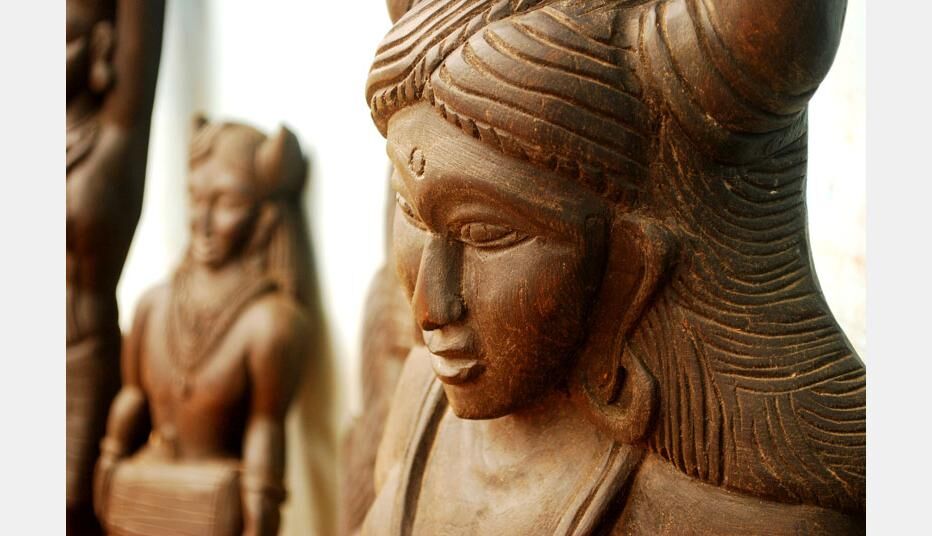Wonder out of wood
Bastar wood craft, traditionally used as a memorial art, has acquired functional attributes and serves as an important source of livelihood

Given the abundance of lush forest, and the relative isolation from trade circuits and routes of army marches, over many centuries, the inhabitants of Bastar evolved a unique art form based on the wood from the trees of Sal (Shorea robusta), Teak (Tectona grandis), Bija (Pterocarpus marsupium), Saja (Terminalia tomentosa), Dhawra (Anogeissus latifolia), Mahua (Madhuca indica), Tendu (Diospyros melanoxylon) and Amla (Embilica officinalis). While the pattern of the Indus valley seals and designs is visible, it was clear that artefacts were produced primarily for the community's functional aesthetic and ritual needs. However, over time, they have become an important source of earning and livelihood, especially as the craft has gained popularity, not just nationally, but also in the global marketplace.
This received an impetus, especially over the last two decades, when the Chhattisgarh Hastshilp Vikas Parishad successfully applied for, and obtained the GI indicator for the wood crafts of Bastar. However, getting the GI indicator requires documentation, and the application included references to, and quotes from authorities like verrier Elwin, DH Gordon, JL Kamath and the ex-maharaja of Bastar to validate the unique geographical imprint of the region.
According to Kamath, the Bastar wood craft began as a memorial art – to acknowledge the brave and the virtuous with wood carved memorials. The Muriya Gonds are believed to have started this tradition in the 11th century. This was then followed by other communities as well. DH Gordon has suggested that at one time the memorials (koruks) were made of stone, and for some time, both wooden and stone memorials co-existed, but the easy availability and malleability of wood made it the preferred medium. The memorial would have symbols as jungle fowls, spiders, birds, body parts like human eye and ear. The technique was then extended from the ritual and totemic to the functional and aesthetic products. According to Verrier Elwin, the tribes of Bastar evolved their own tradition of decorating the wooden fixtures of their houses and shrines with intricately carved upright poles, door panels, ceiling frames, etc. with carved motifs of birds, animals, human figures, floral and totemic designs.
In terms of functional items, the most famous is the Deewan (cot with box). It is indeed very famous and attractive since it involves the art of carving with different pictures of Bastar culture and other designs of interest. The artisans are also skilled in making stunning home decor items such as bed posts, doors, window frames, sculptures and decorative wall-hangings besides wooden ceilings.
Among aesthetic and decorative items, Bastar specialises in traditional boxes, toys, flower vases, bedposts, candle holders, images of deities, among other things. As per Richard Strauss, these have been influenced by the Indus valley painted pottery, especially when it came to motifs which the tribesmen use today on wall and door, on comb and tobacco-case. The basic motifs found in Indus valley civilization were very similar to Bastar motifs such as triangle, swastika, meandering lines, animal, bird, fish, horn, bull head, sun, star, comb, plant, intersecting circles etc. About two centuries ago, some Bengali artists made their way to Bastar, and gave it a Bengali tint. This was also the origin of production of Bastar craft for the market.
Earlier, during Dussehra, one of the most famous festivals celebrated at the place, the tribesmen used to carve a rath made of wood with just an axe, which carried the king at the time of the procession. It was the Kakatiya dynasty which encouraged the artisans of Bastar to do it on a larger scale, as also in making monuments for their decoration purpose.
What then is the unique process of the Bastar woodcraft? The three steps involved in wood carvings include sawing and levelling, splitting, painting and tracing or drawing, and finally carving, smoothening, polishing and finishing. Sawing and levelling involve cutting the trees and making them into logs, which are then purchased by the craftsmen. The wooden planks are cut to particular sizes to meet the requirement of artisans to suit the size of the article to be carved. During splitting, the craftsmen, who practice figurative woodcraft, cut the logs with the help of axes and saws. They are then smoothed with a "Randa" for "Nakkashi" on the smooth surface with the help of pencil or chalk. The designs made by these craftsmen are traditional tribal motifs or imaginative designs. These traditional drawings are not exactly proportionate; therefore, each offering was unique. These days, commercial artists use various measuring devices to give accuracy to the tracings or designs. Carving starts with chiselling so that an outer silhouette of the design is obtained.
As things stand today, wood crafts are an important source of livelihood, and are gaining currency because they are eco-friendly, affordable and cater to the needs of all age groups. The products are now included in the gifts and souvenirs presented by the state government to various dignitaries, and have also been placed in the Durbar Hall of the Rashtrapati Bhawan.
Views expressed are personal



